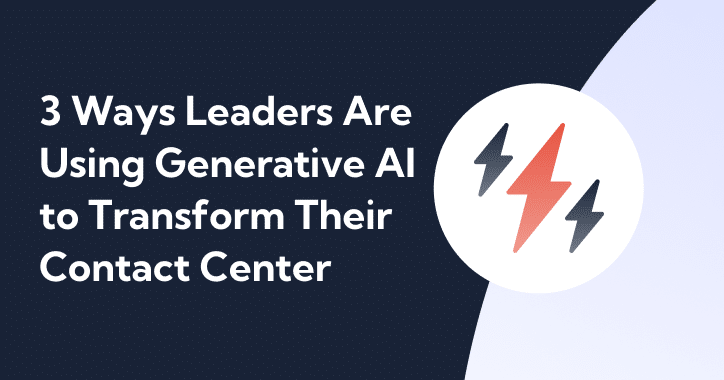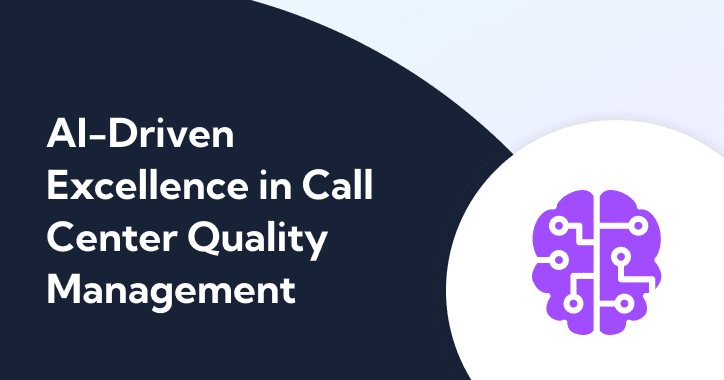The modern contact center strives to be more efficient, more productive, and more profitable than ever, so it’s no surprise that leaders turn to tech to boost performance. But not all solutions are created equal — while collaborative intelligence significantly improves an organization’s bottom line, lazy AI is frustratingly common and far less useful.
Collaborative intelligence learns from the best reps, scales those habits to the entire team, and supports agents through every call with the guidance and insight they actually need to close more sales.
To help you avoid the time and expense of inefficient solutions that don’t fall into the collaborative category, we’ll highlight the red flags you should dodge throughout our Lazy AI in the Contact Center series. In the coming weeks, we’ll uncover how lazy AI negatively affects different facets of the contact center; today, we’re discussing sales outcomes.
In the fast-paced world of sales, “lazy” simply isn’t an option for agents. So why are many contact center solutions built on AI without the speed or skill to enhance sales outcomes, and how can you be sure you’re investing in one of the few true real-time products?
To ensure you positively affect sales when you implement new systems, keep an eye out for these pitfalls that signal lazy AI.
Unsophisticated Systems Leave Problems Unsolved
AI may seem innately modern and advanced, but in reality “AI” simply refers to any computer system with the ability to mimic human cognitive function.
Everything from autocorrect to social media algorithms can rightly be called AI. While relatively simple tech like this makes certain activities easier or more enjoyable, it doesn’t necessarily have the chops to remove the challenges that stand in the way of higher sales rates.
Difficult objections, complicated scripts, a lack of understanding about the customer, and any number of other factors can make sales more difficult. Some contact centers choose “free” software, as VICIdial, in a means of cutting costs without taking into account the hidden costs of the open source call center software. When conversations start to sour, lazy AI may recognize the problem but does little to correct it.
For example, some solutions that claim to work in real time are only glorified alarm systems. They’re designed to send agents alerts when pre-set triggers are tripped. When a trigger occurs, like a customer voicing a frustration, the solution may alert an agent with a message like “Customer Is Angry.”
Although solutions like these actively monitor calls and intervene at critical moments, they’re not actually helping. In fact, pointing out the obvious — like the fact that a customer is unhappy — only distracts agents who are already struggling to close the sale and fails to provide any concrete guidance.
On the other hand, collaborative intelligence that continuously gleans conversational insights can not only recognize that a customer is unhappy, but also offer specific guidance in real-time with methods that have proven successful for other agents on the team.
Elements like machine learning and natural language processing (NLP) must complement AI for a solution to function with the kind of speed and skill necessary to support sales in a contact center.
On its own, AI is only the beginning of a great solution. It takes a whole lot of activity to address a problem rather than point out a symptom on sales calls; systems built on lazy AI just can’t hack it.
Focusing on Keywords Makes Conversations Clunky
Sales calls are a careful dance. A misstep on the part of the agent throws the rhythm of the conversation, then the opportunity is lost.
Scripts are an agent’s roadmap for success, leading them over objections and through every proper turn as they approach a win. But what happens when that roadmap suddenly goes haywire? Lazy AI focused on keywords leaves agents vulnerable to missteps and mishaps, stranding them on calls without the right support.
If a customer says, “I love your product, but my wallet doesn’t,” will a solution built on keyword-matching AI accurately identify the statement as a budget objection? Probably not. In fact, software that relies too heavily on keywords may only pick up on the positive part of that statement and fail to recognize it as an objection at all.
Keyword matching is an important part of most contact center AI, but it shouldn’t be the only part. When it is, the solution fails to properly recognize vital parts of the conversation. Even when agents robotically follow their scripts, there’s no guarantee that a solution will pick up any recognizable keywords from the customer.
By comparison, collaborative intelligence uses intent-based voice processing, allowing agents to have more natural conversations without outpacing their AI. This type of natural language processing enables the use of synonyms, rephrasing, paraphrasing, substitutions, and common idiomatic expressions.
Natural language processing means more organic call flow. This keeps agents engaged with the script but allows them the freedom to adopt their own style so they focus more on forging a meaningful connection with the customer.
Considering that studies show up to 86% of communication in contact centers relies on the tone reps use, agents need to feel comfortable on calls — not stuck in a robotic call center script — if they’re going to increase close rates.
Simply put, keywords are a cop out. Lazy AI that stubbornly sticks to keywords boxes agents into awkward patterns of conversation. Collaborative intelligence makes it easier for agents to stay on a winning path without sounding robotic, leading to better conversations and more wins.
Static Features Reflect Poorly on Agents
No one wants to ask a question about price or availability and then wait 30 seconds in silence as the rep searches for answers. That’s exactly what happens when lazy AI forces agents to perform manual tasks, though.
Solutions with static content leave agents to pick up the slack for their lazy AI. The information may be housed within the solution, and it may even be categorized by keywords, but if it’s not selectively served to agents in real time, then it’s ultimately useless.
When agents can’t stay engaged in the conversation because they’re busy hunting for answers, it reflects poorly on the company and dissuades potential customers from moving forward.
Collaborative intelligence dynamically prompts agents with relevant answers and objection rebuttals. Without missing a beat, agents provide exactly the information customers want — a more seamless experience from real-time means better sales outcomes.
Build a Better Bottom Line with Collaborative Intelligence
Though sales outcomes suffer with lazy AI, the opposite is true with a more robust solution. Collaborative intelligence greatly improves the performance of individual agents and organizations as a whole.
As you seek out solutions to improve sales outcomes in your contact center, keep in mind these hallmarks of lazy AI. Remember that if a solution can’t work in real time, then it simply can’t drive sales.
As the industry-leading Real-Time Guidance solution, Balto understands the challenges associated with building efficient, collaborative intelligence. We also know that if support doesn’t arrive in real time, then it’s arriving too late, leading to missed opportunities and stagnant profit — challenging though it may be, real-time is vital for improving sales outcomes.
For more insight into why real-time is the only real solution for modern contact centers, read the Definitive Guide to Real-Time Guidance, Coaching, and QA.






